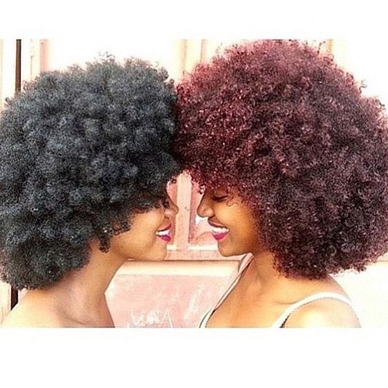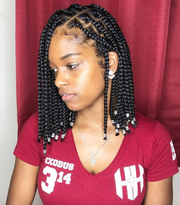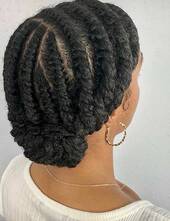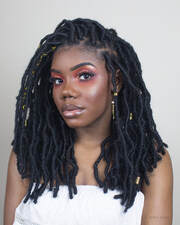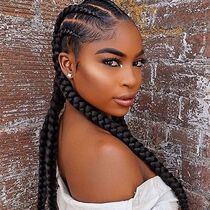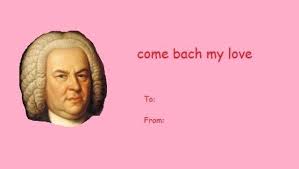"With this new season coming up, more protective styles are starting to make an appearance." - Aeryon Jackson, 10th
With this new season coming up, more protective styles are starting to make an appearance. But what is a protective style?
Protective styles are hairstyles that African American women wear to protect the ends of their natural hair. This helps to hide your hair from exposure and decrease tangling, shedding, and breakage. “The ends of your hair are the oldest and most fragile parts of your hair. You want to treat your ends with a lot more tenderness than other parts of the hair,” clarified Raw Remedies in the article The Importance of Wearing Protective Hairstyles. Some celebrities you might’ve seen rocking some protective hairstyles recently include Rihanna or Zendaya.
You’ve also probably seen some white celebrities such as Kim Kardashian wearing braids, along with other non-Black people on the internet. This is considered cultural appropriation.
Cultural appropriation is the adoption of an element of one's culture or identity by members of another culture of identity. Black hair has a very unique texture, and has always had social significance to African Americans going centuries back. “The discovery of ancient stone paintings depicting women with cornrows in North Africa shows that braids date back thousands of years,” writes Sirrad Dirshe in the article Respect Our Roots: A Brief History about Braids.
In Pre-Colonial Africa, before the Slave-Trade, complicated braided, twisted, and threaded styles would be used to express your status, whether or not you were married, and if you had gone through puberty. In the article Respect Our Roots: A Brief History about Braids Lori T Harps, a professor at Temple University and the coauthor of Hair Story: Untangling the Roots of Black Hair in America, explains that “people would use braids as a map to freedom. For instance, the number of plaits worn could indicate how many roads people needed to walk or where to meet someone to escape bondage.”
Here are some examples of more Protective Hairstyles:
Protective styles are hairstyles that African American women wear to protect the ends of their natural hair. This helps to hide your hair from exposure and decrease tangling, shedding, and breakage. “The ends of your hair are the oldest and most fragile parts of your hair. You want to treat your ends with a lot more tenderness than other parts of the hair,” clarified Raw Remedies in the article The Importance of Wearing Protective Hairstyles. Some celebrities you might’ve seen rocking some protective hairstyles recently include Rihanna or Zendaya.
You’ve also probably seen some white celebrities such as Kim Kardashian wearing braids, along with other non-Black people on the internet. This is considered cultural appropriation.
Cultural appropriation is the adoption of an element of one's culture or identity by members of another culture of identity. Black hair has a very unique texture, and has always had social significance to African Americans going centuries back. “The discovery of ancient stone paintings depicting women with cornrows in North Africa shows that braids date back thousands of years,” writes Sirrad Dirshe in the article Respect Our Roots: A Brief History about Braids.
In Pre-Colonial Africa, before the Slave-Trade, complicated braided, twisted, and threaded styles would be used to express your status, whether or not you were married, and if you had gone through puberty. In the article Respect Our Roots: A Brief History about Braids Lori T Harps, a professor at Temple University and the coauthor of Hair Story: Untangling the Roots of Black Hair in America, explains that “people would use braids as a map to freedom. For instance, the number of plaits worn could indicate how many roads people needed to walk or where to meet someone to escape bondage.”
Here are some examples of more Protective Hairstyles:
Bob-length Singles
These braids are free-hanging and ideal because they aren’t too heavy to where they pull at your roots. They last for weeks and take almost zero effort to maintain.
These braids are free-hanging and ideal because they aren’t too heavy to where they pull at your roots. They last for weeks and take almost zero effort to maintain.
Flat Twists
This style is quicker and easier to do than cornrows. They make a nice updo and could be worn for a couple of weeks.
This style is quicker and easier to do than cornrows. They make a nice updo and could be worn for a couple of weeks.
Faux Locs
This style helps you protect your hair from battering wind and rain, and the scorching heat of the sun. It is low maintenance and could last for weeks as long as you ensure your hair is well moisturized.
This style helps you protect your hair from battering wind and rain, and the scorching heat of the sun. It is low maintenance and could last for weeks as long as you ensure your hair is well moisturized.
Cornrows
Cornrows are a classic look for black women. They’re favored because you could twist and turn them into multiple different looks.
Cornrows are a classic look for black women. They’re favored because you could twist and turn them into multiple different looks.
